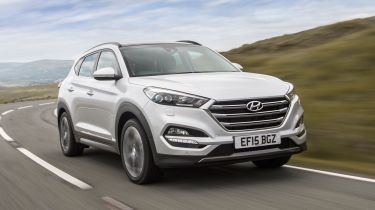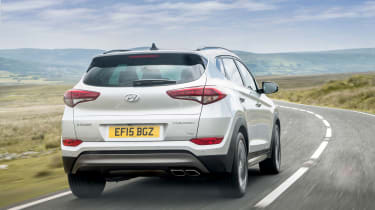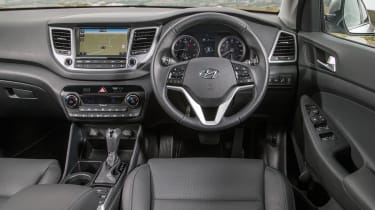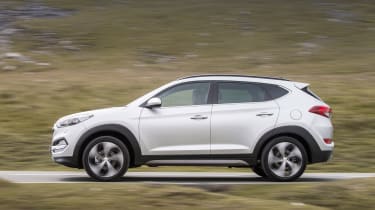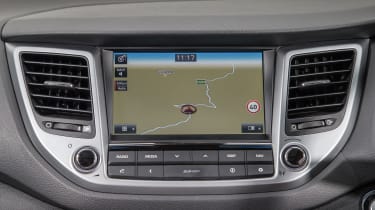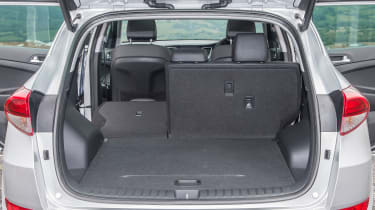New Hyundai Tucson 2015 review
We drive the new Hyundai Tucson 1.7-litre diesel - the expected best-seller - for the first time in the UK

Hyundai has done more than just add some style to its product portfolio with the Tucson, which was the brand’s immediate priority. It’s mini-SUV proportions will shine in a sector which shows no sign of letting up in terms of demand, while a composed drive, supple ride and abundance of space make it a thoroughly recommendable crossover. Add in a five year, unlimited mileage warranty and the Tucson covers all the bases any family could ask of it.
Hyundai’s new Tucson is a car with some big shoes to fill – it's replacing the popular ix35 and needs to tempt buyers away from the accomplished Nissan Qashqai and sleek Mazda CX-5.
That would be a tough enough ask on its own, but following on from a car which accounted for more than 20 per cent of the brand’s entire sales last year, as well as enticing a new breed of customers with a renewed focus on style is a daunting task for any newcomer.
We’ve been behind the wheel of the Tucson before, having sampled high powered petrol and diesel models – as well as early pre-production versions – but those are likely to make up only a fraction of overall sales. What we have here, and in the UK for the first time, is the expected best seller – the 115bhp 1.7-litre diesel paired with a six-speed manual gearbox.
Used - available now

2023 Hyundai
Tucson
43,361 milesAutomaticPetrol1.6L
Cash £22,063
2023 Hyundai
Tucson
34,825 milesManualPetrol1.6L
Cash £19,163
2020 Hyundai
Tucson
29,213 milesAutomaticPetrol1.6L
Cash £14,850
2023 Hyundai
Tucson
23,534 milesAutomaticPetrol1.6L
Cash £22,300The engine may be one of the few adopted components from the old ix35, but for the Tucson Hyundai has tweaked it to meet strict Euro6 emissions regulations. A quick glance at the spec sheet immediately makes it the standout option for most family buyers, being the most efficient and cleanest in the range by some distance – with CO2 emissions of 119g/km and combined 61.4mpg – as well as representing decent value for money priced from £20,195 in entry-level S trim.
The SE Nav spec of our test car bumps the price up to £22,795 but for that you get an eight-inch touchscreen with navigation, heated seats and reversing camera on top of alloy wheels, air-conditioning and Bluetooth.
A like-for-like Qashqai may promise a slightly better 70mpg and emit only 103g/km of CO2, but if you want to match the Tucson for kit inside you’ll have to fork out a further £1,000.
It’s clear, even from the outside, the Tucson has benefited from having a talented sibling sitting above it in the model range in the shape of the Santa Fe. Slightly softer and more curvaceous body panels are the Tucson’s distinguishing features, but the bold front grille and rising shoulder line inject some attitude, giving it vital showroom appeal which sees it rise above the Kuga and Qashqai in the style stakes.
Step inside and it feels more spacious, too. The horizontal layout of the dash adds to the sense of space, while the logical and clutter-free arrangement of controls and buttons eclipses the Kuga when it comes to ease of use.
However, while it may look good, some of the plastics that litter the dash and centre console are rather questionable and detract from the premium image. Moving further up the range won’t get rid of them either - not something you’d expect of a model range which tops out at over £32,000.
There’ll be fewer complaints when it comes to practicality, however. The boot opening is wide and low and serves up 513 litres of space, trumping all of its closest competitors. Fold the rear seats into the boot floor and that figure rises to 1,503 litres, while the taller body and longer wheelbase over the ix35 provides ample space for the three adults in the rear.
On the move, a sacrifice you have to make for the impressive economy is a lack of pace. For the most part, power is fed to the front wheels – there’s no 4WD option on the 1.7 – smoothly and cleanly, with the engine only beginning to feel strangled above 3,000rpm.
The 13.4 second 0-62mph time feels like a rather unfair reflection, as the 270Nm of torque helps you maintain speed - coming in at a useful 1,250rpm. You’ll have to step up to the new 2.0-litre diesel if you fancy an automatic gearbox, but the smooth and weighty gear change from the standard manual transmissions makes it an unnecessary option.
The way the Tucson rolls down the road makes it feel very much like a more compact Santa Fe. In fact, Hyundai even spent time in the UK developing the Tucson specifically for UK roads, and it shows. It never feels fazed by our rutted tarmac, with the retuned springs and dampers absorbing bumps admirably, while the stiffer body structure of the Tucson over the ix35 means exceptionally neat body control.

